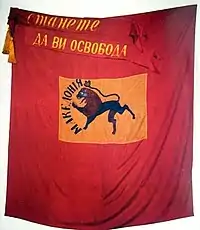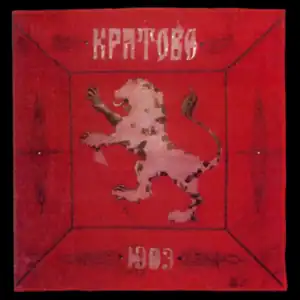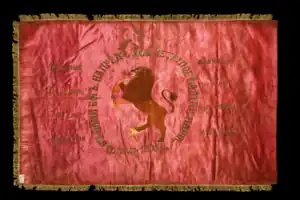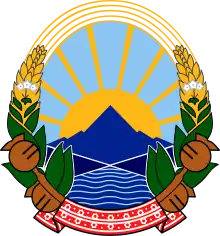| Coat of arms proposed in 2014 by the Macedonian government[1] | |
|---|---|
 | |
| Armiger | North Macedonia |
| Blazon | Or, a lion Gules. Above the shield a mural crown with five turrets Or, 4 pearls Argent and 5 gems Gules |
The Macedonian lion is an unofficial symbol of North Macedonia. After the independence of the Republic of Macedonia from Yugoslavia, the lion was proposed as a coat of arms of the new independent state several times.
Background
From the end of the 16th till the end of the 18th centuries, the region of North Macedonia was commonly represented in foreign armorials with a coat of arms depicting a golden lion on red field, or red lion on golden field. The earliest known example of this is the Fojnica Armorial[2] from 16/17 century,[3][4] and later examples include the Korenić-Neorić armorial of 1595,[5][6] a 1620 armorial on display in the Belgrade Museum of Contemporary Art, and a 17th-century armorial in Berlin Library.[7] The Korenić-Neorić armory roll of 1595 included a five-pointed crown.[8] The Belgrade Museum of Contemporary Art displays a 1620 version of the symbol with a three-pointed crown, while the Berlin Library displays a 17th-century version with the five-pointed crown.[7] The use of the lion to represent Macedonia was continued in foreign heraldic collections throughout the 16th to 18th centuries[9][10]
During the late 19th century the Internal Macedonian-Adrianople Revolutionary Organization arose, which aim was the autonomy for Macedonia and Adrianople regions. The organization modeled itself after the earlier Bulgarian revolutionary traditions and adopted their symbols as the lion, motto, etc.[11][12][13][14][15] It was disbanded in 1934 by the Bulgarian army after a military coup. Several Macedonian parties have claimed after 1990 a line descent from the old IMARO.[16]
Proposed introduction
The Republic of North Macedonia had no heraldic emblem when the country gained independence from Yugoslavia, but since then this emblem has often been proposed as a replacement for the non-heraldic national emblem of the republic, a remnant of socialistic symbolism.[9][10] Such efforts have so far failed, due to political and national disputes over possible replacements. A proposal by architect and graphic designer Miroslav Grčev was put forward in 1992 to replace it with a revised version of the historical gold lion on a red shield. However, this was rejected on three main grounds:
- several political parties, notably VMRO-DPMNE, already use that emblem as their party symbols
- the Albanian political parties of Macedonia considered the proposal to be only representative for the ethnic Macedonians, but not also for ethnic Albanians
- the state coat of arms of Bulgaria is somewhat similar (but not identical)
Because of these reasons, the political parties agreed to continue to use the current device until a solution is found. The emblem did not appear on the country's first passports, however, in 2007 the device was put on the front and the inside of the new biometric Macedonian passports, while the parliamentary debate about acceptance of a new national emblem still continues.
According to the provisions of the Article 5, Section 2 of the Constitution of Macedonia, the two-thirds majority is required to pass a law on the new symbols of the Republic. The usage of the Coat of arms has been defined by a law.[17]
In 2009 Internal Macedonian Revolutionary Organization–People's Party proposed the golden lion on red background as a new coat of arms of Macedonia, based on the traditional logo of the historical VMRO, but it was not accepted. On the 5 December 2014 the VMRO-DPMNE government of the Republic of Macedonia, in accordance with the then policy of Antiquization, proposed a coat of arms which would replace the old national emblem. According to the Macedonian Heraldry Society, the new coat of arms is based on an illustration from Jerome de Bara (1581).[1] The illustration from de Bara's book "Le blason des armoiries" depicts attributed arms of Alexander the Great.[18] It is blazoned as "Or, a lion gules" (on a golden background, a red lion) and topped with a golden mural crown to represent the republican form of government. The parliament did not vote on this design.[19]
Present usage
The coat of arms with a golden lion on a red shield is used to represent several Macedonian political parties, including the largest one; Internal Macedonian Revolutionary Organization – Democratic Party for Macedonian National Unity and Internal Macedonian Revolutionary Organization–People's Party. At the same time, the lion as a symbol of these parties is inherited from the original organization VMRO, where it was borrowed from the Bulgarian coat of arms.[20][21]
Gallery
- Historical examples of renditions
 From the Korenić-Neorić armorial (1595)
From the Korenić-Neorić armorial (1595).jpg.webp) Macedonian Coat of Arms, Althan’s or Bolognas’ Roll (1614)
Macedonian Coat of Arms, Althan’s or Bolognas’ Roll (1614) Coat of arms of Macedonia, Belgrade II Roll (1620)
Coat of arms of Macedonia, Belgrade II Roll (1620) From the armorial Le blason des armoiries (1628), by Jérôme de Bara
From the armorial Le blason des armoiries (1628), by Jérôme de Bara From 1694, by Pavao Ritter Vitezović[22]
From 1694, by Pavao Ritter Vitezović[22] Coat of Arms of Macedonia, Fojnica 17th century
Coat of Arms of Macedonia, Fojnica 17th century.jpg.webp) From Stemmatographia (1741), by Hristofor Zhefarovich
From Stemmatographia (1741), by Hristofor Zhefarovich Fictional flag of Alexander the Great in Năstase Negrule's version of the Alexander Romance, 1790
Fictional flag of Alexander the Great in Năstase Negrule's version of the Alexander Romance, 1790.jpg.webp) Zefarovic's Stemmatographia in Rila monastery which depicts the Serbian, Bulgarian, Bosnian and Macedonian coat of arms (top left to bottom right). They were made in 1883 within the Bulgarian Principality, by the painter Nikola Obrazopisov.[23]
Zefarovic's Stemmatographia in Rila monastery which depicts the Serbian, Bulgarian, Bosnian and Macedonian coat of arms (top left to bottom right). They were made in 1883 within the Bulgarian Principality, by the painter Nikola Obrazopisov.[23] Insurgent Banner used in the Razlovci Uprising, 1876. The flag which states "Awaken to Liberate Macedonia" was made on the order and per a model sent by BRCK-leader Vasil Levski by two schoolmistresses, his relatives.[24]
Insurgent Banner used in the Razlovci Uprising, 1876. The flag which states "Awaken to Liberate Macedonia" was made on the order and per a model sent by BRCK-leader Vasil Levski by two schoolmistresses, his relatives.[24] Flag of the Kratovo IMARO insurgents used during the Ilinden uprising. On the flag is depicted Bulgarian lion and the year 1903.[25]
Flag of the Kratovo IMARO insurgents used during the Ilinden uprising. On the flag is depicted Bulgarian lion and the year 1903.[25] Flag of the Ohrid insurgents used during the Ilinden uprising, 1903. The lion is depicted dismembering the Islamic star and crescent. On the flag is written part of the Hristo Botev's 1873 poem dedicated to Hadzhi Dimitar.
Flag of the Ohrid insurgents used during the Ilinden uprising, 1903. The lion is depicted dismembering the Islamic star and crescent. On the flag is written part of the Hristo Botev's 1873 poem dedicated to Hadzhi Dimitar.
Alternatives
 First unofficial proposal.[26]
First unofficial proposal.[26] Second unofficial proposal.[26]
Second unofficial proposal.[26] Coat of arms proposed in 1992, by Miroslav Grčev. This was the most popular proposed arms before the government's 2014 proposal.
Coat of arms proposed in 1992, by Miroslav Grčev. This was the most popular proposed arms before the government's 2014 proposal.
See also
References
- 1 2 "The Government has adopted the proposal for a new Coat of Arms for the Republic of Macedonia - Macedonian Heraldry Society". heraldika.org.mk. 6 December 2014.
- ↑ Fojnica Armory Archived 2011-07-06 at the Wayback Machine, online images
- ↑ Ivan Supercic, Croatia in the Late Middle Ages and the Renaissance: A Cultural Survey, Philip Wilson Publishers, 2009, ISBN 0856676241, p. 30.
- ↑ "Fojnica (Municipality, Central Bosnian Canton, Bosnia and Herzegovina)". fotw.info. Retrieved 2019-04-13.
- ↑ Zrinka Blazevic, 'Indetermi-nation: Narrative identity and symbolic politics in early modern Illyrism', chapter 6 of: Whose Love of Which Country?: Composite States, National Histories and Patriotic Discourses in Early Modern East Central Europe, Balázs Trencsényi and Márton Zászkaliczky (eds.), BRILL, 2010, ISBN 978-90-04-18262-2
- ↑ Milic Milicevic, „Грб Србије, развој кроз историју“, Belgrade 1995, ISBN 86-7549-047-X
- 1 2 "Земскиот грб". Archived from the original on 2009-09-17. Retrieved 2009-09-22.
- ↑ Clancy, Tim (2013). Bosnia and Herzegovina. Bradt Travel Guides. ISBN 9781841624495.
- 1 2 Matkovski, Aleksandar, Grbovite na Makedonija, Skopje, 1970
- 1 2 Александар Матковски (1990) Грбовите на Македонија, Мисла, Skopje, Macedonia - ISBN 86-15-00160-X
- ↑ Duncan M. Perry, The Politics of Terror: The Macedonian Liberation Movements, 1893-1903, Duke University Press, 1988, pp. 39-40.
- ↑ J. Pettifer as ed., The New Macedonian Question, Springer, 1999 ISBN 0230535798, p. 236.
- ↑ Georgi Rakovski described for the first time the lion and this motto in the poem "Горски пътник", written in 1854 and issued in 1857. The plot of this poem concerns a Bulgarian who recruits a rebel cheta to mutiny against the Turks. It was used for the first time during the 1860s from the Bulgarian Legions in Serbia. Then Georgi Rakovski ordered a flag and a seal with the inscriptions "Свобода или смърть". Rakovski summoned his fellow countrymen to go to the battle fields under the banners of the Bulgarian lion depicted dismembering the Islamic symbols. Veselin Nikolov Traĭkov, G. Mukherjee, Georgi Stoikov Rakovski, a Great Son of Bulgaria and a Great Friend of India, Northern Book Centre, ISBN 8185119287, p. 127.
- ↑ Per the memoirs of one of the founders of the IMARO - Hristo Tatarchev, at the beginning of 1894, they attempted to work out the Statute of the new organization. The founders had near at hand a volume of the Notes on the Bulgarian uprisings written by the Bulgarian revolutionary Zahari Stoyanov and an exemplar of the Statute of the Bulgarian Revolutionary Central Committee, and used them as a models. Petar Poparsov worked out a draft-Statute on the basis of this documents. For more see: Mercia MacDermott, Freedom Or Death: The Life of Gotse Delchev, Pluto Press, 1978, ISBN 0904526321, p. 99.
- ↑ On the cover of the first statute of the Organization, which at the time was called Bulgarian Macedonian-Adrianople Revolutionary Committees, is depicted a woman holding a flag with her right hand, on which is written "Svoboda ili smart". She is leaning on a pedestal on which a standing Bulgarian lion with a crown is depicted. With her left hand she holds a shield on which "Macedonia" is written. At the woman's feet lies a broken Ottoman flag with a half-moon and a torn chains. As described by the Bulgarian historian Tsotsho Bilyarski per ЦДА, ф. 1932 к, оп. 3, а. е. 1, л. 23.
- ↑ As organization's initial name shows ("Bulgarian Macedonian-Adrianople Revolutionary Committees"), it had a Bulgarian national character: the revolutionary leaders were quite often teachers from the Bulgarian schools in Macedonia. This was the case of founders of the organization... Their organization was popularly seen in the local context as "the Bulgarian committee(s). For more see: Tchavdar Marinov, Famous Macedonia, the Land of Alexander: Macedonian identity at the crossroads of Greek, Bulgarian and Serbian nationalism in Entangled Histories of the Balkans - Volume One: National Ideologies and Language Policies with Roumen Daskalov and Tchavdar Marinov as ed., BRILL, 2013, ISBN 900425076X, pp. 273-330.
- ↑ Zakon za upotreba na grbot, znameto i himnata na Republika Makedonija ("Služben vesnik na Republika Makedonija", No. 32/97 Archived 2008-04-20 at the Wayback Machine, 1997-07-09)
- ↑ Bara, Jérôme de (1628). "Le blason des armoiries". google.com.
- ↑ "Macedonia with new state emblem". Gazeta Express (in Albanian).
- ↑ Тодор Петров, Нелегалната армия на ВМОРО в Македония и Одринско: 1899 - 1908, изд. "Свети Георги победоносец", 1993, стр. 133.
- ↑ Liubomir Panaĭotov, Ilindensko-Preobrazhenskoto vŭstanie ot 1903 g: voenna podgotovka i provezhdane, Institut za voenna istoria, 1992, str. 167.
- ↑ Makedonsko Heraldicko Zdruzenie/Macedonian Heraldry Society Archived 2009-09-17 at the Wayback Machine, Zemski Grbovi
- ↑ Николай Цвятков Кочев, Николай Ст Шиваров, Международен симпозиум 1100 години от блажената кончина на св. Методий, том 2, Църковноисторически и архивен институт при Българската патриаршия, Духовна академия "Св. Климент Охридски." Синодално изд-во, 1989, стр. 167.
- ↑ Огняна Панайотова Маждракова-Чавдарова, Националната революция, делото на Васил Левски и освобождението на България. Общобългарски комитет и фондация "Васил Левски", 1998 стр. 97. ISBN 9548259346.
- ↑ Bulgarian museum of military history official site, where the flag is kept with its description in Bulgarian.
- 1 2 "Macedonian coat of arms on heraldika.org.mk". Archived from the original on 11 January 2011. Retrieved 8 October 2010.
External links
 Media related to Proposed national coats of arms of North Macedonia at Wikimedia Commons
Media related to Proposed national coats of arms of North Macedonia at Wikimedia Commons
